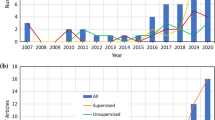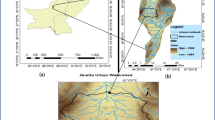Abstract
This paper reports the analysis of soil radon data recorded in the seismic zone-V, located in the northeastern part of India (latitude 23.73N, longitude 92.73E). Continuous measurements of soil-gas emission along Chite fault in Mizoram (India) were carried out with the replacement of solid-state nuclear track detectors at weekly interval. The present study was done for the period from March 2013 to May 2015 using LR-115 Type II detectors, manufactured by Kodak Pathe, France. In order to reduce the influence of meteorological parameters, statistical analysis tools such as multiple linear regression and artificial neural network have been used. Decrease in radon concentration was recorded prior to some earthquakes that occurred during the observation period. Some false anomalies were also recorded which may be attributed to the ongoing crustal deformation which was not major enough to produce an earthquake.






Similar content being viewed by others
References
Arafa, W. (2002). Permeability of radon-222 through some materials. Radiation Measurements, 35, 207–211.
Chyi, L. L., Quick, T. J., Yang, T. F., & Chen, C. H. (2005). Soil gas radon spectra and earthquakes. Terrestrial, Atmospheric and Oceanic Sciences, 16, 763–774.
Dewey, J. F., & Bird, J. M. (1970). Mountain belts and the new global tectonics. Journal of Geophysical Research, 75, 2625–2647.
Dobrovolsky, I. P., Zubkov, S. I., & Miachkin, V. I. (1979). Estimation of the size of earthquake preparation zones. Pure and Applied Geophysics, 117, 1025–1044.
Etiope, G., & Lombardi, S. (1995). Evidence for radon transport by carrier gas through faulted clays in Italy. Journal of Radioanalytical and Nuclear Chemistry, 193, 291–300.
Fu, C. C., Yang, T. F., Walia, V., & Cheng, C. H. (2005). Reconnaissance of soil gas composition over the buried fault and fracture zone in southern Taiwan. Geochemical Journal, 39, 427–439.
Ghosh, D., Deb, A., & Sengupta, R. (2009). Anomalous radon emission as precursor of earthquakes. Journal of Applied Geophysics, 69, 67–81.
Giacomino, A., Abollino, O., Malandrino, M., & Mentasti, E. (2011). The role chemometrics in single and sequential extraction assays: A review. Part II. Cluster analysis, multiple linear regression, mixture resolution, experimental design and other techniques. Analytica Chimica Acta, 688, 122–139.
Guerra, M., & Lombardi, S. (2001). Soil-gas method for tracing neotectonic faults in clay basin: The Pisticci field (southern Italy). Tectonophysics, 339, 511–522.
Haykin, S. (1994). Neural networks: A comprehensive foundation. New Jersey: Prentice-Hall Inc.
Hocking, R. R. (1976). The analysis and selection of variables in linear regression. Biometrics, 32, 1–49.
Igarashi, G., Sacki, S., Takahata, N., Sumikawa, K., Tasaka, S., Sasaki, Y., et al. (1995). Groundwater radon anomaly before the Kobe earthquake in Japan. Science, 269, 60–61.
Jaacks, J. A. (1984). Meteorological influence upon mercury, radon and helium soil gas emission. Ph.D. Thesis, Colorado School of mines.
Jaishi, H. P., Singh, S., Tiwari, R. P., & Tiwari, R. C. (2013). Radon and thoron anomalies along Mat fault in Mizoram, India. Journal of Earth System Science, 122, 1507–1513.
Jaishi, H. P., Singh, S., Tiwari, R. P., & Tiwari, R. C. (2014a). Correlation of radon anomalies with seismic events along Mat fault in Serchhip District, Mizoram, India. Applied Radiation and Isotopes, 86, 79–84.
Jaishi, H. P., Singh, S., Tiwari, R. P., & Tiwari, R. C. (2014b). Temporal variation of soil radon and thoron concentrations in Mizoram (India), associated with earthquakes. Natural Hazards, 72, 443–454.
Jönsson, G. (1981). The angular sensitivity of Kodak LR-film to alpha particles. Nuclear Instruments and Methods in Physics Research, 190, 407–414.
King, C. Y. (1986). Gas geochemistry applied to earthquake prediction: An overview. Journal of Geophysical Research, 91, 12269–12281.
King, C.-Y., & Wakita, H. (1981). Anomalous radon changes in an artesian well and possible relation to earthquake (abstract). Earthquake Notes, 52(1), 71.
Kraner, H. W., Schroeder, G. L., & Evans, R. D. (1964). Measurement of the effects of atmospheric variables on radon-222 flux and soil-gas concentrations. In L. A. S. Adams & W. M. Lowder (Eds.), Symposium Proceedings of Natural Radiation Environment, Houston, Texas (pp. 191–214), 10–13 April 1963. University of Chicago Press: Chicago.
Külahci, F., & Çiçek, Ş. (2014). Time-series analysis of water and soil radon anomalies to identify micro-macro-earthqaukes. Arabian Journal of Geosciences, 8(7), 5239–5246.
Külahci, F., Inceoz, M., Dogru, M., Aksoy, E., & Baykara, O. (2009). Artificial neural network model for earthquake prediction with radon monitoring. Applied Radiation and Isotopes, 67, 212–219.
Külahci, F., & Şen, Z. (2014). On the correction of spatial and statistical uncertainties in systematic measurements of 222Rn for earthquake prediction. Surveys in Geophysics, 35(2), 449–478.
Kuo, T., Su, C., Chang, C., Lin, C., Cheng, W., Liang, H., et al. (2010). Application of recurrent radon precursors for forecasting large earthquakes (Mw > 6.0) near Antung, Taiwan. Radiation Measurements, 45, 1049–1054.
Latt, Z. Z., & Wittenberg, H. (2014). Improving flood forecasting in a developing country: A comparative study of stepwise multiple linear regression and artificial neural network. Water Resources Management, 28, 2109–2128.
Liu, K. K., Yui, T. F., Tasi, Y. B., & Teng, T. L. (1984). Variation of radon content in groundwater and possible correlation with seismic activities in the northern Taiwan. Pure and Applied Geophysics, 122, 231–244.
Mayya, Y. S., Eappen, K. P., & Nambi, K. S. V. (1998). Methodology for mixed field inhalation dosimetry in monazite areas using a twin-cup dosimeter with three track detectors. Radiation Protection Dosimetry, 77, 177–184.
Negarestani, A., Setayeshi, S., Ghannadi-Maragheh, M., & Akashe, B. (2002). Layered neural networks based analysis of radon concentration and environmental parameters in earthquake prediction. Journal of Environmental Radioactivity, 62, 225–233.
Price, J. G., Christensen, L., Hess, R., La Pointe, D. D., Ramelli, A. R., Desilets, M., et al. (1994). Radon in outdoor air in Nevada. Health Physics, 66, 433–438.
Ramachandran, T. V., Lalit, B. Y., & Mishra, U. C. (1987). Measurement of radon permeability through some membranes. International Journal of Radiation Applications and Instrumentation Part D Nuclear Tracks and Radiation Measurements, 13, 81–84.
Rannou, A. (1989). The bare detector and results of indoor radon survey in France. In Proceedings of International Workshop on Radon monitoring in Radioprotection, Environmental Radioactivity and Earth Science (pp. 145–222).
Rawat, U. S., & Parihar, C. P. S. (2001). Geoenvironment of Mizoram and its implication in development. In Proceedings of National Symposium–Role of Earth Sciences in Integrated Development and Related Societal Issues, GSISP–65 (I), 185–190.
Sen, Z., & Birpinar, M. E. (2004). Water resources assessment, IACWRA 2004 Lecture Notes (p. 100). Istanbul: Water Engineering Research and Development Center.
Singh, S., Jaishi, H.P., Tiwari, R.P., Tiwari, R.C. (2014). Variations of soil radon concentrations along Chite Fault in Aizawl district, Mizoram, India. Radiation Protection Dosimetry. doi:10.1093/rpd/ncu221.
Singh, M., Kumar, M., Jain, R. K., & Chatrath, R. P. (1999). Radon in ground water related to seismic events. Radiation Measurements, 30, 465–469.
Stranden, E., Kolstad, A. K., & Lind, B. (1984). The influence of moisture and temperature on radon exhalation. Radiation Protection Dosimetry, 7, 55–58.
The Mathworks Inc. (2007). Version R2007a. New Jersey: Prentice Hall.
Virk, H. S., Walia, V., & Kumar, N. (2001). Radon/helium precursory signals of Chamoli earthquakes, Garhwal Himalaya, India. Journal of Geodynamics, 31, 201–210.
Virk, H. S., Walia, V., Sharma, A. K., Kumar, N., & Kumar, R. (2000). Correlation of radon with microsiesmic events in Kangra and Chamba Valleys of N-W Himalaya. Geofisica Internacional, 39, 221–227.
Walia, V., Virk, H. S., Yang, T. F., Mahajan, S., Walia, M., & Bajwa, B. S. (2005). Earthquake prediction studies using radon as a precursor in NW Himalayas, India: A case study. Terrestrial, Atmospheric and Oceanic Sciences, 16, 775–804.
Wattananikorn, K., Kanaree, M., & Wiboolsake, S. (1998). Soil gas radon as an earthquake precursor: Some considerations on data improvement. Radiation Measurements, 29, 593–598.
Zurada, J. M. (1992). Introduction to artificial neural systems (p. 683). St. Paul: West Publishing Company.
Acknowledgements
This work has been funded by the Ministry of Earth Sciences (MoES), Govt. of India, New Delhi, in the form of Major project vide Sanction Order No. MoES/P.O.(Seismo)/1(167)/2013 dated 10.12.2013.
Author information
Authors and Affiliations
Corresponding author
Rights and permissions
About this article
Cite this article
Singh, S., Jaishi, H.P., Tiwari, R.P. et al. Time Series Analysis of Soil Radon Data Using Multiple Linear Regression and Artificial Neural Network in Seismic Precursory Studies. Pure Appl. Geophys. 174, 2793–2802 (2017). https://doi.org/10.1007/s00024-017-1556-4
Received:
Revised:
Accepted:
Published:
Issue Date:
DOI: https://doi.org/10.1007/s00024-017-1556-4




